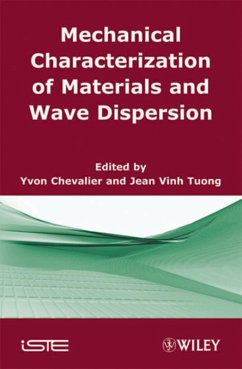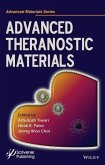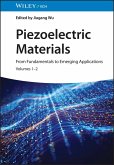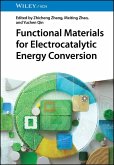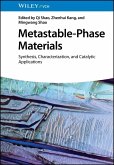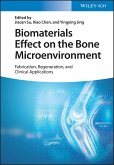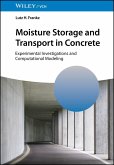Mechanical Characterization of Materials and Wave Dispersion
Instrumentation and Experiment Interpretation
Herausgegeben von Chevalier, Yvon; Tuong, Jean Vinh
Mechanical Characterization of Materials and Wave Dispersion
Instrumentation and Experiment Interpretation
Herausgegeben von Chevalier, Yvon; Tuong, Jean Vinh
- Gebundenes Buch
- Merkliste
- Auf die Merkliste
- Bewerten Bewerten
- Teilen
- Produkt teilen
- Produkterinnerung
- Produkterinnerung
Over the last 50 years, the methods of investigating dynamic properties have resulted in significant advances. This book explores dynamic testing, the methods used, and the experiments performed, placing a particular emphasis on the context of bounded medium elastodynamics. Dynamic tests have proven to be as efficient as static tests and are often easier to use at lower frequency. The discussion is divided into four parts. Part A focuses on the complements of continuum mechanics. Part B concerns the various types of rod vibrations: extensional, bending, and torsional. Part C is devoted to…mehr
Andere Kunden interessierten sich auch für
![Advanced Theranostic Materials Advanced Theranostic Materials]() Ashutosh TiwariAdvanced Theranostic Materials230,99 €
Ashutosh TiwariAdvanced Theranostic Materials230,99 €![Piezoelectric Materials Piezoelectric Materials]() Piezoelectric Materials173,99 €
Piezoelectric Materials173,99 €![Nano and Micro-Scale Energetic Materials, 2 Volumes Nano and Micro-Scale Energetic Materials, 2 Volumes]() Nano and Micro-Scale Energetic Materials, 2 Volumes221,99 €
Nano and Micro-Scale Energetic Materials, 2 Volumes221,99 €![Functional Materials for Electrocatalytic Energy Conversion Functional Materials for Electrocatalytic Energy Conversion]() Functional Materials for Electrocatalytic Energy Conversion155,99 €
Functional Materials for Electrocatalytic Energy Conversion155,99 €![Metastable-Phase Materials Metastable-Phase Materials]() Metastable-Phase Materials93,99 €
Metastable-Phase Materials93,99 €![Biomaterials Effect on the Bone Microenvironment Biomaterials Effect on the Bone Microenvironment]() Biomaterials Effect on the Bone Microenvironment95,99 €
Biomaterials Effect on the Bone Microenvironment95,99 €![Moisture Storage and Transport in Concrete Moisture Storage and Transport in Concrete]() Lutz H. FrankeMoisture Storage and Transport in Concrete107,99 €
Lutz H. FrankeMoisture Storage and Transport in Concrete107,99 €-
-
-
Over the last 50 years, the methods of investigating dynamic properties have resulted in significant advances. This book explores dynamic testing, the methods used, and the experiments performed, placing a particular emphasis on the context of bounded medium elastodynamics. Dynamic tests have proven to be as efficient as static tests and are often easier to use at lower frequency. The discussion is divided into four parts. Part A focuses on the complements of continuum mechanics. Part B concerns the various types of rod vibrations: extensional, bending, and torsional. Part C is devoted to mechanical and electronic instrumentation, and guidelines for which experimental set-up should be used are given. Part D concentrates on experiments and experimental interpretations of elastic or viscolelastic moduli. In addition, several chapters contain practical examples alongside theoretical discussion to facilitate the readers understanding. The results presented are the culmination of over 30 years of research by the authors and as such will be of great interest to anyone involved in this field.
Hinweis: Dieser Artikel kann nur an eine deutsche Lieferadresse ausgeliefert werden.
Hinweis: Dieser Artikel kann nur an eine deutsche Lieferadresse ausgeliefert werden.
Produktdetails
- Produktdetails
- ISTE
- Verlag: ISTE / Wiley & Sons
- 1. Auflage
- Seitenzahl: 458
- Erscheinungstermin: 20. Juli 2010
- Englisch
- Abmessung: 234mm x 155mm x 33mm
- Gewicht: 866g
- ISBN-13: 9781848211933
- ISBN-10: 1848211937
- Artikelnr.: 29952928
- Herstellerkennzeichnung
- Libri GmbH
- Europaallee 1
- 36244 Bad Hersfeld
- gpsr@libri.de
- ISTE
- Verlag: ISTE / Wiley & Sons
- 1. Auflage
- Seitenzahl: 458
- Erscheinungstermin: 20. Juli 2010
- Englisch
- Abmessung: 234mm x 155mm x 33mm
- Gewicht: 866g
- ISBN-13: 9781848211933
- ISBN-10: 1848211937
- Artikelnr.: 29952928
- Herstellerkennzeichnung
- Libri GmbH
- Europaallee 1
- 36244 Bad Hersfeld
- gpsr@libri.de
Yvon Chevalier is Emeritus Professor at the Institut Superieur de Mécanique de Paris (SUPMECA), France. Since 2000 he has been coeditor-in-chief of Mecanique et Industries journal, supported by the French Association of Mechanics. He is a well-known expert in the dynamics of composite materials and propagation of waves in heterogeneous materials. He also has extensive experience in the areas of hyper-elasticity and non-linear viscoelasticity of rubber materials. Jean Tuong Vinh is Emeritus University Professor of Mechanical Engineering at the University of Paris VI in France. He carries out research into theoretical viscoelasticity, non-linear functional Volterra series, computer algorithms in signal processing, frequency Hilbert transform, special impact testing, wave dispersion in rods and continuous elements and solution of related inverse problems.
Preface xxi Acknowledgements xxxi PART I - MECHANICAL AND ELECTRONIC INSTRUMENTATION 1 Chapter 1. Guidelines for Choosing the Experimental Set-up 3 Jean Tuong VINH 1.1. Choice of matrix coefficient to be evaluated and type of wave to be adopted 4 1.2. Influence of frequency range 8 1.3. Dimensions and shape of the samples 9 1.4. Tests at high and low temperature 10 1.5. Sample holder at high temperature 10 1.6. Visual observation inside the ambient room 11 1.7. Complex moduli of viscoelastic materials and damping capacity measurements 11 1.8. Previsional calculation of composite materials 11 1.9. Bibliography 11 Chapter 2. Review of Industrial Analyzers for Material Characterization 13 Jean Tuong VINH 2.1. Rheovibron and its successive versions 14 2.2. Dynamic mechanical analyzer DMA 01dB-Metravib and VHF 104 Metravib analyzer 17 2.3. Bruel and Kjaer complex modulus apparatus (Oberst Apparatus) 18 2.4. Dynamic mechanical analyzer DMA - Dupont de Nemours 980 20 2.5. Elasticimeter using progressive wave PPM 5 22 2.6. Bibliography 24 Chapter 3. Mechanical Part of the Vibration Test Bench 25 Jean Tuong VINH 3.1. Clamping end 25 3.2. Length correction 29 3.3. Supported end 33 3.4. Additional weight or additional torsion lever used as a boundary condition 34 3.5. Free end 34 3.6. Pseudo-clamping sample attachment 35 3.7. Sample suspended by taut threads 38 3.8. Sample on foam rubber plate serving as a mattress 41 3.9. Climatic chamber 41 3.10. Vacuum system 41 3.11. Bibliography 42 Chapter 4. Exciters and Excitation Signals 43 Jean Tuong VINH 4.1. Frequency ranges 43 4.2. Power 43 4.3. Nature and performance of various exciters 44 4.4. Room required for exciter installation 47 4.5. Details for electrodynamic shakers 48 4.6. Low cost electromagnetic exciters with permanent magnet 54 4.7. Piezoelectric and ferroelectric exciters 55 4.8. Design of special ferroelectric transducers 67 4.9. Power piezoelectric exciters 69 4.10. Technical details concerning ultrasonic emitters for the measurement of material stiffness coefficients on ultrasonic test benches 70 4.11. Bibliography 74 4.12. Appendix 4A. Example of ferroelectric plates and disks 74 Chapter 5. Transducers 77 Jean Tuong VINH and Michel NUGUES 5.1. Introduction 77 5.2. Transducers and their principal performance 78 5.3. The main classes of fixed reference transducers 79 5.4. Condenser-type transducer 82 5.5. Inductance transducers 89 5.6. Mutual inductance transducer 92 5.7. Differential transformer transducer 93 5.8. Contactless inductance transducer with a permanent magnet 93 5.9. Eddy current transducer 94 5.10. Seismic transducers 97 5.11. Piezoresistive accelerometer 109 5.12. Other transducers 110 5.13. Force transducers 111 5.14. Bibliography 113 5.15. Appendix 5A. Condenser with polarization 113 5.16. Appendix 5B. Eigenfrequencies of some force transducers: Rayleigh and Rayleigh-Ritz upper bound methods 115 5B.1. Rayleigh's method 116 5B.2. Rayleigh-Ritz's method 117 5B.3. Preliminary experimental test on the force transducer 117 Chapter 6. Electronic Instrumentation, Connecting Cautions and Signal Processing 119 Jean Tuong VINH 6.1. Preamplifiers and signal conditioners following the transducers 120 6.2. Cables and wiring considerations 121 6.3. Transducer selection and mountings 123 6.4. Transducer calibration 129 6.5. Digital signal processing systems: an overview 133 6.6. Other signal processing programs 141 6.7. Reasoned choice of excitation signals 142 6.8. Bibliography 146 6.9. Appendix 6A. The Shannon theorem and aliasing phenomenon 147 6.10. Appendix 6B. Time window (or weighting function)150 6B.1. Kaiser-Bessel window 151 6B.2. Hamming window 152 Chapter 7. The Frequency Hilbert Transform and Detection of Hidden Non-linearities in Frequency Responses 155 Jean Tuong VINH 7.1. Introduction 155 7.2. Mathematical expression of the Hilbert transform 157 7.3. Kramer-Kronig's relationships 162 7.4. Causal signal and Fourier transform 163 7.5. Hilbert transform of a truncated transfer function 164 7.6. Impulse response of a system. Non-causality due to measurement defects 172 7.7. Summary of principal result in sections 7.5 and 7.6 174 7.8. Causalized Hilbert transform 175 7.9. Some practical aspects of Hilbert transform computation 176 7.10. Conclusion 181 7.11. Bibliography 181 7.12. Appendix 7A. Line integral of complex function and Cauchy's integral 182 7A.1. Analyticity of a function f(z) of complex variable z 182 7A.2. Expression of Cauchy's integral of the function f(z)/(z-
183 7.13. Appendix 7B. Hilbert transform obtained directly by Guillemin's method 184 Chapter 8. Measurement of Structural Damping 187 Jean Tuong VINH 8.1. Introduction 187 8.2. Overview of various methods used to evaluate damping ratios in structural dynamics 190 8.3. Measurement of structural damping coefficient by multimodal analysis 197 8.4. The Hilbert envelope time domain method 201 8.5. Detection of hidden non-linearities 203 8.6. How to relate material damping to structural damping? 203 8.7. Concluding remarks 207 8.8. Bibliography 208 PART II - REALIZATION OF EXPERIMENTAL SET-UPS AND INTERPRETATION OF MEASUREMENTS 209 Chapter 9. Torsion Test Benches: Instrumentation and Experimental Results 211 Michel NUGUES 9.1. Introduction 211 9.2. Industrial torsion test bench 211 9.3. Parasitic bending vibration of rod 215 9.4. Shear moduli of transverse isotropic materials 215 9.5. Elastic moduli obtained for various materials 220 9.6. Experimental set-up to obtain dispersion curves in a large frequency range 222 9.7. Experimental results obtained on short samples 224 9.8. Experimental wave dispersion curves obtained by torsional vibrations of a rod with rectangular cross-section 227 9.9. Frequency spectrum for isotropic metallic materials (aluminum and steel alloy) 230 9.10. Impact test on viscoelastic high damping material 232 9.11. Concluding remarks 238 9.12. Bibliography 239 9.13. Appendix 9A. Choice of equations of motion 240 9A.1. Circular cross-section 240 9A.2. Square cross-section 241 9A.3. Rectangular cross-section 241 9A.4. Ratio of Young's modulus to shear modulus 241 9A.5. Special experimental studies of wave dispersion phenomenon 242 9.14. Appendix 9B. Complementary information concerning formulae used to interpret torsion tests 242 9B.1. Quick overview of Saint Venant's theory applied to the problem of dynamic Torsion 242 9.15. Appendix 9C. Details concerning the ß
(c) function in the calculation of rod stiffness CT 245 9.16. Appendix 9D. Compliments concerning the solution of equations of motion with first order theory 246 9D.1. Displacement field 246 9D.2. Relations between two sets of coefficients 246 9D.3. Equations giving the two sets of coefficients Aa, Ba, Ca, Da deduced from the four boundary conditions 248 9D.4. Evaluation of coefficients in [9D.6] 248 9D.5. Equations in Aa, Ba, Ca, Da deduced from the four boundary conditions 249 Chapter 10. Bending Vibration of Rod Instrumentation and Measurements 255 Dominique LE NIZHERY 10.1. Introduction 255 10.2. Realization of an elasticimeter 255 10.3. How to conduct bending tests 262 10.4. Concluding remarks 267 10.5 Bibliography 268 10.6. Appendix 10A. Useful formulae to evaluate the Young's modulus by bending vibration of rods 268 10A.1. Bernoulli-Euler's equation 268 10A.2. Timoshenko-Mindlin's equation 269 10A.3. Boundary conditions and wave number equation 269 10A.4. Important parameters in rod bending vibration 269 10A.5. Expression of the wave number 270 10A.6. Young's modulus (Bernoulli's theory) 270 10A.7. Young's modulus (Timoshenko-Mindlin's equation) 270 Chapter 11. Longitudinal Vibrations of Rods: Material Characterization and Experimental Dispersion Curves 271 Yvon CHEVALIER and Jean Tuong VINH 11.1. Introduction 271 11.2. Mechanical set-up 272 11.3. Electronic set-up 272 11.4. Estimation of phase velocity 274 11.5. Short samples and eigenvalue calculations for various materials 280 11.6. Experimental results interpreted by the two theories 283 11.7. Influence of slenderness (
L = 2L/h) on eigenfrequency 291 11.8. Experimental results obtained with short rod 292 11.9. Concluding remarks 292 11.10. Bibliography 295 11.11. Appendix 11A. Eigenvalue equation for rod of finite length 296 11.12. Appendix 11B. Additional information concerning solutions of Touratier's equations 300 11B.1. Eigenequation with elementary theory of motion 301 Chapter 12. Realization of Le Rolland-Sorin's Double Pendulum and Some Experimental Results 305 Mostefa ARCHI and Jean-Baptiste CASIMIR 12.1. Introduction 305 12.2. Principal mechanical parts of the double pendulum system 305 12.3. Instrumentation 312 12.4. Experimental precautions 315 12.5. Details and characteristics of the elasticimeter 317 12.6. Some experimental results 318 12.7. Damping ratio estimation by logarithmic decrement method 322 12.8. Concluding remarks 324 12.9. Bibliography 325 12.10. Appendix 12A. Equations of motion for the set (pendulums, platform and sample) and Young's modulus calculation deduced from bending tests 326 12A.1. Equations of motion 326 12A.2. Solutions for pendulum oscillations 328 12A.3. Relationship between beating period
and sample stiffness k 329 12A.4. Young's modulus calculation 330 12.11. Appendix 12B. Evaluation of shear modulus by torsion tests 331 12B.1. Energy expression 331 Chapter 13. Stationary and Progressive Waves in Rings and Hollow Cylinders 335 Yvon CHEVALIER and Jean Tuong VINH 13.1. Introduction 335 13.2. Choosing the samples based on material symmetry 336 13.3. Practical realization of a special elasticimeter for curved beams and rings: in plane bending vibrations 337 13.4. Ultrasonic benches 342 13.5. Experimental results and interpretation 343 13.6. List of symbols 358 13.7. Bibliography 359 13.8. Appendix 13A. Evaluation of Young's modulus by using in plane bending motion of the ring 359 13.9. Appendix 13B. Determination of inertia moment of a solid by means of a three-string pendulum 360 13B.1. Principle of the method 360 13B.2. Calculations 361 13.10. Appendix 13C. Necessary formulae to evaluate Young's modulus of a straight beam 364 Chapter 14. Ultrasonic Benches: Characterization of Materials by Wave Propagation Techniques 367 Patrick GARCEAU 14.1. Introduction 367 14.2. Ultrasonic transducers 367 14.3. Pulse generator 369 14.4. Mechanical realization of ultrasonic benches 371 14.5. Experimental interpretation of phase velocity and group velocity 375 14.6. Some experimental results on composite materials 380 14.7. Viscoelastic characterization of materials by ultrasonic waves 383 14.8. Bibliography 388 14.9. Appendix 14A. Oblique incidence and energy propagation direction 389 14.10. Appendix 14B. Water immersion bench, measurement of coefficients of stiffness matrix 392 14B.1. Expression of phase velocity in the sample 393 14B.2. Phase velocity measurement by propagation time (?·?nt ) evaluation 394 14B.3. Phase velocity evaluation without time measurements 394 Chapter 15. Wave Dispersion in Rods with a Rectangular Cross-section: Higher Order Theory and Experimentation 397 Maurice TOURATIER 15.1. Introduction 397 15.2. Summary table of some wave dispersion research 398 15.3. Longitudinal wave dispersion: influence of the material and geometry of the bounded medium 399 15.4. Bending wave dispersion 403 15.5. First order for torsional motion in a transverse isotropic rod 408 15.6. Interest in theories with higher degrees of approximation 414 15.7. Experimental set-ups to visualize stationary waves in rods 416 15.8. Electronic set-up and observed signals on a multi-channel oscilloscope 421 15.9. Presentation of experimental results 424 15.10. Concluding remarks 427 15.11. Bibliography 428 15.12. Appendix 15A. Touratier's theory using Hellinger-Reissner's mixed fields 429 15A.1. Outline of Touratier's mixed field theory 429 15A.2. General equations deduced from the two fields principle 432 15A.3. Formulation of the boundary condition problem 432 15A.4. Symmetry considerations concerning the three kinds of motion 433 15A.5. Truncating process for one dimensional theories: extensional waves 437 15A.6. Equations of motion for extensional movement 438 15A.7. Effective front velocity and wave front velocity 439 15A.8. Bending equations of motion 441 15A.9. Equations of motion: torsional vibration 444 15.13. Appendix 15B. Third order Touratier's theory 445 15B.1. Extensional waves with nine evaluated modes 446 15B.2. Geometrical characteristics of displacement components uj mn and physical interpretation 447 15B.3. Bending mode in the direction x
- geometrical interpretation 448 15B.4. Shear motion around longitudinal rod axis 450 List of Authors 453 Index 455
183 7.13. Appendix 7B. Hilbert transform obtained directly by Guillemin's method 184 Chapter 8. Measurement of Structural Damping 187 Jean Tuong VINH 8.1. Introduction 187 8.2. Overview of various methods used to evaluate damping ratios in structural dynamics 190 8.3. Measurement of structural damping coefficient by multimodal analysis 197 8.4. The Hilbert envelope time domain method 201 8.5. Detection of hidden non-linearities 203 8.6. How to relate material damping to structural damping? 203 8.7. Concluding remarks 207 8.8. Bibliography 208 PART II - REALIZATION OF EXPERIMENTAL SET-UPS AND INTERPRETATION OF MEASUREMENTS 209 Chapter 9. Torsion Test Benches: Instrumentation and Experimental Results 211 Michel NUGUES 9.1. Introduction 211 9.2. Industrial torsion test bench 211 9.3. Parasitic bending vibration of rod 215 9.4. Shear moduli of transverse isotropic materials 215 9.5. Elastic moduli obtained for various materials 220 9.6. Experimental set-up to obtain dispersion curves in a large frequency range 222 9.7. Experimental results obtained on short samples 224 9.8. Experimental wave dispersion curves obtained by torsional vibrations of a rod with rectangular cross-section 227 9.9. Frequency spectrum for isotropic metallic materials (aluminum and steel alloy) 230 9.10. Impact test on viscoelastic high damping material 232 9.11. Concluding remarks 238 9.12. Bibliography 239 9.13. Appendix 9A. Choice of equations of motion 240 9A.1. Circular cross-section 240 9A.2. Square cross-section 241 9A.3. Rectangular cross-section 241 9A.4. Ratio of Young's modulus to shear modulus 241 9A.5. Special experimental studies of wave dispersion phenomenon 242 9.14. Appendix 9B. Complementary information concerning formulae used to interpret torsion tests 242 9B.1. Quick overview of Saint Venant's theory applied to the problem of dynamic Torsion 242 9.15. Appendix 9C. Details concerning the ß
(c) function in the calculation of rod stiffness CT 245 9.16. Appendix 9D. Compliments concerning the solution of equations of motion with first order theory 246 9D.1. Displacement field 246 9D.2. Relations between two sets of coefficients 246 9D.3. Equations giving the two sets of coefficients Aa, Ba, Ca, Da deduced from the four boundary conditions 248 9D.4. Evaluation of coefficients in [9D.6] 248 9D.5. Equations in Aa, Ba, Ca, Da deduced from the four boundary conditions 249 Chapter 10. Bending Vibration of Rod Instrumentation and Measurements 255 Dominique LE NIZHERY 10.1. Introduction 255 10.2. Realization of an elasticimeter 255 10.3. How to conduct bending tests 262 10.4. Concluding remarks 267 10.5 Bibliography 268 10.6. Appendix 10A. Useful formulae to evaluate the Young's modulus by bending vibration of rods 268 10A.1. Bernoulli-Euler's equation 268 10A.2. Timoshenko-Mindlin's equation 269 10A.3. Boundary conditions and wave number equation 269 10A.4. Important parameters in rod bending vibration 269 10A.5. Expression of the wave number 270 10A.6. Young's modulus (Bernoulli's theory) 270 10A.7. Young's modulus (Timoshenko-Mindlin's equation) 270 Chapter 11. Longitudinal Vibrations of Rods: Material Characterization and Experimental Dispersion Curves 271 Yvon CHEVALIER and Jean Tuong VINH 11.1. Introduction 271 11.2. Mechanical set-up 272 11.3. Electronic set-up 272 11.4. Estimation of phase velocity 274 11.5. Short samples and eigenvalue calculations for various materials 280 11.6. Experimental results interpreted by the two theories 283 11.7. Influence of slenderness (
L = 2L/h) on eigenfrequency 291 11.8. Experimental results obtained with short rod 292 11.9. Concluding remarks 292 11.10. Bibliography 295 11.11. Appendix 11A. Eigenvalue equation for rod of finite length 296 11.12. Appendix 11B. Additional information concerning solutions of Touratier's equations 300 11B.1. Eigenequation with elementary theory of motion 301 Chapter 12. Realization of Le Rolland-Sorin's Double Pendulum and Some Experimental Results 305 Mostefa ARCHI and Jean-Baptiste CASIMIR 12.1. Introduction 305 12.2. Principal mechanical parts of the double pendulum system 305 12.3. Instrumentation 312 12.4. Experimental precautions 315 12.5. Details and characteristics of the elasticimeter 317 12.6. Some experimental results 318 12.7. Damping ratio estimation by logarithmic decrement method 322 12.8. Concluding remarks 324 12.9. Bibliography 325 12.10. Appendix 12A. Equations of motion for the set (pendulums, platform and sample) and Young's modulus calculation deduced from bending tests 326 12A.1. Equations of motion 326 12A.2. Solutions for pendulum oscillations 328 12A.3. Relationship between beating period
and sample stiffness k 329 12A.4. Young's modulus calculation 330 12.11. Appendix 12B. Evaluation of shear modulus by torsion tests 331 12B.1. Energy expression 331 Chapter 13. Stationary and Progressive Waves in Rings and Hollow Cylinders 335 Yvon CHEVALIER and Jean Tuong VINH 13.1. Introduction 335 13.2. Choosing the samples based on material symmetry 336 13.3. Practical realization of a special elasticimeter for curved beams and rings: in plane bending vibrations 337 13.4. Ultrasonic benches 342 13.5. Experimental results and interpretation 343 13.6. List of symbols 358 13.7. Bibliography 359 13.8. Appendix 13A. Evaluation of Young's modulus by using in plane bending motion of the ring 359 13.9. Appendix 13B. Determination of inertia moment of a solid by means of a three-string pendulum 360 13B.1. Principle of the method 360 13B.2. Calculations 361 13.10. Appendix 13C. Necessary formulae to evaluate Young's modulus of a straight beam 364 Chapter 14. Ultrasonic Benches: Characterization of Materials by Wave Propagation Techniques 367 Patrick GARCEAU 14.1. Introduction 367 14.2. Ultrasonic transducers 367 14.3. Pulse generator 369 14.4. Mechanical realization of ultrasonic benches 371 14.5. Experimental interpretation of phase velocity and group velocity 375 14.6. Some experimental results on composite materials 380 14.7. Viscoelastic characterization of materials by ultrasonic waves 383 14.8. Bibliography 388 14.9. Appendix 14A. Oblique incidence and energy propagation direction 389 14.10. Appendix 14B. Water immersion bench, measurement of coefficients of stiffness matrix 392 14B.1. Expression of phase velocity in the sample 393 14B.2. Phase velocity measurement by propagation time (?·?nt ) evaluation 394 14B.3. Phase velocity evaluation without time measurements 394 Chapter 15. Wave Dispersion in Rods with a Rectangular Cross-section: Higher Order Theory and Experimentation 397 Maurice TOURATIER 15.1. Introduction 397 15.2. Summary table of some wave dispersion research 398 15.3. Longitudinal wave dispersion: influence of the material and geometry of the bounded medium 399 15.4. Bending wave dispersion 403 15.5. First order for torsional motion in a transverse isotropic rod 408 15.6. Interest in theories with higher degrees of approximation 414 15.7. Experimental set-ups to visualize stationary waves in rods 416 15.8. Electronic set-up and observed signals on a multi-channel oscilloscope 421 15.9. Presentation of experimental results 424 15.10. Concluding remarks 427 15.11. Bibliography 428 15.12. Appendix 15A. Touratier's theory using Hellinger-Reissner's mixed fields 429 15A.1. Outline of Touratier's mixed field theory 429 15A.2. General equations deduced from the two fields principle 432 15A.3. Formulation of the boundary condition problem 432 15A.4. Symmetry considerations concerning the three kinds of motion 433 15A.5. Truncating process for one dimensional theories: extensional waves 437 15A.6. Equations of motion for extensional movement 438 15A.7. Effective front velocity and wave front velocity 439 15A.8. Bending equations of motion 441 15A.9. Equations of motion: torsional vibration 444 15.13. Appendix 15B. Third order Touratier's theory 445 15B.1. Extensional waves with nine evaluated modes 446 15B.2. Geometrical characteristics of displacement components uj mn and physical interpretation 447 15B.3. Bending mode in the direction x
- geometrical interpretation 448 15B.4. Shear motion around longitudinal rod axis 450 List of Authors 453 Index 455
Preface xxi Acknowledgements xxxi PART I - MECHANICAL AND ELECTRONIC INSTRUMENTATION 1 Chapter 1. Guidelines for Choosing the Experimental Set-up 3 Jean Tuong VINH 1.1. Choice of matrix coefficient to be evaluated and type of wave to be adopted 4 1.2. Influence of frequency range 8 1.3. Dimensions and shape of the samples 9 1.4. Tests at high and low temperature 10 1.5. Sample holder at high temperature 10 1.6. Visual observation inside the ambient room 11 1.7. Complex moduli of viscoelastic materials and damping capacity measurements 11 1.8. Previsional calculation of composite materials 11 1.9. Bibliography 11 Chapter 2. Review of Industrial Analyzers for Material Characterization 13 Jean Tuong VINH 2.1. Rheovibron and its successive versions 14 2.2. Dynamic mechanical analyzer DMA 01dB-Metravib and VHF 104 Metravib analyzer 17 2.3. Bruel and Kjaer complex modulus apparatus (Oberst Apparatus) 18 2.4. Dynamic mechanical analyzer DMA - Dupont de Nemours 980 20 2.5. Elasticimeter using progressive wave PPM 5 22 2.6. Bibliography 24 Chapter 3. Mechanical Part of the Vibration Test Bench 25 Jean Tuong VINH 3.1. Clamping end 25 3.2. Length correction 29 3.3. Supported end 33 3.4. Additional weight or additional torsion lever used as a boundary condition 34 3.5. Free end 34 3.6. Pseudo-clamping sample attachment 35 3.7. Sample suspended by taut threads 38 3.8. Sample on foam rubber plate serving as a mattress 41 3.9. Climatic chamber 41 3.10. Vacuum system 41 3.11. Bibliography 42 Chapter 4. Exciters and Excitation Signals 43 Jean Tuong VINH 4.1. Frequency ranges 43 4.2. Power 43 4.3. Nature and performance of various exciters 44 4.4. Room required for exciter installation 47 4.5. Details for electrodynamic shakers 48 4.6. Low cost electromagnetic exciters with permanent magnet 54 4.7. Piezoelectric and ferroelectric exciters 55 4.8. Design of special ferroelectric transducers 67 4.9. Power piezoelectric exciters 69 4.10. Technical details concerning ultrasonic emitters for the measurement of material stiffness coefficients on ultrasonic test benches 70 4.11. Bibliography 74 4.12. Appendix 4A. Example of ferroelectric plates and disks 74 Chapter 5. Transducers 77 Jean Tuong VINH and Michel NUGUES 5.1. Introduction 77 5.2. Transducers and their principal performance 78 5.3. The main classes of fixed reference transducers 79 5.4. Condenser-type transducer 82 5.5. Inductance transducers 89 5.6. Mutual inductance transducer 92 5.7. Differential transformer transducer 93 5.8. Contactless inductance transducer with a permanent magnet 93 5.9. Eddy current transducer 94 5.10. Seismic transducers 97 5.11. Piezoresistive accelerometer 109 5.12. Other transducers 110 5.13. Force transducers 111 5.14. Bibliography 113 5.15. Appendix 5A. Condenser with polarization 113 5.16. Appendix 5B. Eigenfrequencies of some force transducers: Rayleigh and Rayleigh-Ritz upper bound methods 115 5B.1. Rayleigh's method 116 5B.2. Rayleigh-Ritz's method 117 5B.3. Preliminary experimental test on the force transducer 117 Chapter 6. Electronic Instrumentation, Connecting Cautions and Signal Processing 119 Jean Tuong VINH 6.1. Preamplifiers and signal conditioners following the transducers 120 6.2. Cables and wiring considerations 121 6.3. Transducer selection and mountings 123 6.4. Transducer calibration 129 6.5. Digital signal processing systems: an overview 133 6.6. Other signal processing programs 141 6.7. Reasoned choice of excitation signals 142 6.8. Bibliography 146 6.9. Appendix 6A. The Shannon theorem and aliasing phenomenon 147 6.10. Appendix 6B. Time window (or weighting function)150 6B.1. Kaiser-Bessel window 151 6B.2. Hamming window 152 Chapter 7. The Frequency Hilbert Transform and Detection of Hidden Non-linearities in Frequency Responses 155 Jean Tuong VINH 7.1. Introduction 155 7.2. Mathematical expression of the Hilbert transform 157 7.3. Kramer-Kronig's relationships 162 7.4. Causal signal and Fourier transform 163 7.5. Hilbert transform of a truncated transfer function 164 7.6. Impulse response of a system. Non-causality due to measurement defects 172 7.7. Summary of principal result in sections 7.5 and 7.6 174 7.8. Causalized Hilbert transform 175 7.9. Some practical aspects of Hilbert transform computation 176 7.10. Conclusion 181 7.11. Bibliography 181 7.12. Appendix 7A. Line integral of complex function and Cauchy's integral 182 7A.1. Analyticity of a function f(z) of complex variable z 182 7A.2. Expression of Cauchy's integral of the function f(z)/(z-
183 7.13. Appendix 7B. Hilbert transform obtained directly by Guillemin's method 184 Chapter 8. Measurement of Structural Damping 187 Jean Tuong VINH 8.1. Introduction 187 8.2. Overview of various methods used to evaluate damping ratios in structural dynamics 190 8.3. Measurement of structural damping coefficient by multimodal analysis 197 8.4. The Hilbert envelope time domain method 201 8.5. Detection of hidden non-linearities 203 8.6. How to relate material damping to structural damping? 203 8.7. Concluding remarks 207 8.8. Bibliography 208 PART II - REALIZATION OF EXPERIMENTAL SET-UPS AND INTERPRETATION OF MEASUREMENTS 209 Chapter 9. Torsion Test Benches: Instrumentation and Experimental Results 211 Michel NUGUES 9.1. Introduction 211 9.2. Industrial torsion test bench 211 9.3. Parasitic bending vibration of rod 215 9.4. Shear moduli of transverse isotropic materials 215 9.5. Elastic moduli obtained for various materials 220 9.6. Experimental set-up to obtain dispersion curves in a large frequency range 222 9.7. Experimental results obtained on short samples 224 9.8. Experimental wave dispersion curves obtained by torsional vibrations of a rod with rectangular cross-section 227 9.9. Frequency spectrum for isotropic metallic materials (aluminum and steel alloy) 230 9.10. Impact test on viscoelastic high damping material 232 9.11. Concluding remarks 238 9.12. Bibliography 239 9.13. Appendix 9A. Choice of equations of motion 240 9A.1. Circular cross-section 240 9A.2. Square cross-section 241 9A.3. Rectangular cross-section 241 9A.4. Ratio of Young's modulus to shear modulus 241 9A.5. Special experimental studies of wave dispersion phenomenon 242 9.14. Appendix 9B. Complementary information concerning formulae used to interpret torsion tests 242 9B.1. Quick overview of Saint Venant's theory applied to the problem of dynamic Torsion 242 9.15. Appendix 9C. Details concerning the ß
(c) function in the calculation of rod stiffness CT 245 9.16. Appendix 9D. Compliments concerning the solution of equations of motion with first order theory 246 9D.1. Displacement field 246 9D.2. Relations between two sets of coefficients 246 9D.3. Equations giving the two sets of coefficients Aa, Ba, Ca, Da deduced from the four boundary conditions 248 9D.4. Evaluation of coefficients in [9D.6] 248 9D.5. Equations in Aa, Ba, Ca, Da deduced from the four boundary conditions 249 Chapter 10. Bending Vibration of Rod Instrumentation and Measurements 255 Dominique LE NIZHERY 10.1. Introduction 255 10.2. Realization of an elasticimeter 255 10.3. How to conduct bending tests 262 10.4. Concluding remarks 267 10.5 Bibliography 268 10.6. Appendix 10A. Useful formulae to evaluate the Young's modulus by bending vibration of rods 268 10A.1. Bernoulli-Euler's equation 268 10A.2. Timoshenko-Mindlin's equation 269 10A.3. Boundary conditions and wave number equation 269 10A.4. Important parameters in rod bending vibration 269 10A.5. Expression of the wave number 270 10A.6. Young's modulus (Bernoulli's theory) 270 10A.7. Young's modulus (Timoshenko-Mindlin's equation) 270 Chapter 11. Longitudinal Vibrations of Rods: Material Characterization and Experimental Dispersion Curves 271 Yvon CHEVALIER and Jean Tuong VINH 11.1. Introduction 271 11.2. Mechanical set-up 272 11.3. Electronic set-up 272 11.4. Estimation of phase velocity 274 11.5. Short samples and eigenvalue calculations for various materials 280 11.6. Experimental results interpreted by the two theories 283 11.7. Influence of slenderness (
L = 2L/h) on eigenfrequency 291 11.8. Experimental results obtained with short rod 292 11.9. Concluding remarks 292 11.10. Bibliography 295 11.11. Appendix 11A. Eigenvalue equation for rod of finite length 296 11.12. Appendix 11B. Additional information concerning solutions of Touratier's equations 300 11B.1. Eigenequation with elementary theory of motion 301 Chapter 12. Realization of Le Rolland-Sorin's Double Pendulum and Some Experimental Results 305 Mostefa ARCHI and Jean-Baptiste CASIMIR 12.1. Introduction 305 12.2. Principal mechanical parts of the double pendulum system 305 12.3. Instrumentation 312 12.4. Experimental precautions 315 12.5. Details and characteristics of the elasticimeter 317 12.6. Some experimental results 318 12.7. Damping ratio estimation by logarithmic decrement method 322 12.8. Concluding remarks 324 12.9. Bibliography 325 12.10. Appendix 12A. Equations of motion for the set (pendulums, platform and sample) and Young's modulus calculation deduced from bending tests 326 12A.1. Equations of motion 326 12A.2. Solutions for pendulum oscillations 328 12A.3. Relationship between beating period
and sample stiffness k 329 12A.4. Young's modulus calculation 330 12.11. Appendix 12B. Evaluation of shear modulus by torsion tests 331 12B.1. Energy expression 331 Chapter 13. Stationary and Progressive Waves in Rings and Hollow Cylinders 335 Yvon CHEVALIER and Jean Tuong VINH 13.1. Introduction 335 13.2. Choosing the samples based on material symmetry 336 13.3. Practical realization of a special elasticimeter for curved beams and rings: in plane bending vibrations 337 13.4. Ultrasonic benches 342 13.5. Experimental results and interpretation 343 13.6. List of symbols 358 13.7. Bibliography 359 13.8. Appendix 13A. Evaluation of Young's modulus by using in plane bending motion of the ring 359 13.9. Appendix 13B. Determination of inertia moment of a solid by means of a three-string pendulum 360 13B.1. Principle of the method 360 13B.2. Calculations 361 13.10. Appendix 13C. Necessary formulae to evaluate Young's modulus of a straight beam 364 Chapter 14. Ultrasonic Benches: Characterization of Materials by Wave Propagation Techniques 367 Patrick GARCEAU 14.1. Introduction 367 14.2. Ultrasonic transducers 367 14.3. Pulse generator 369 14.4. Mechanical realization of ultrasonic benches 371 14.5. Experimental interpretation of phase velocity and group velocity 375 14.6. Some experimental results on composite materials 380 14.7. Viscoelastic characterization of materials by ultrasonic waves 383 14.8. Bibliography 388 14.9. Appendix 14A. Oblique incidence and energy propagation direction 389 14.10. Appendix 14B. Water immersion bench, measurement of coefficients of stiffness matrix 392 14B.1. Expression of phase velocity in the sample 393 14B.2. Phase velocity measurement by propagation time (?·?nt ) evaluation 394 14B.3. Phase velocity evaluation without time measurements 394 Chapter 15. Wave Dispersion in Rods with a Rectangular Cross-section: Higher Order Theory and Experimentation 397 Maurice TOURATIER 15.1. Introduction 397 15.2. Summary table of some wave dispersion research 398 15.3. Longitudinal wave dispersion: influence of the material and geometry of the bounded medium 399 15.4. Bending wave dispersion 403 15.5. First order for torsional motion in a transverse isotropic rod 408 15.6. Interest in theories with higher degrees of approximation 414 15.7. Experimental set-ups to visualize stationary waves in rods 416 15.8. Electronic set-up and observed signals on a multi-channel oscilloscope 421 15.9. Presentation of experimental results 424 15.10. Concluding remarks 427 15.11. Bibliography 428 15.12. Appendix 15A. Touratier's theory using Hellinger-Reissner's mixed fields 429 15A.1. Outline of Touratier's mixed field theory 429 15A.2. General equations deduced from the two fields principle 432 15A.3. Formulation of the boundary condition problem 432 15A.4. Symmetry considerations concerning the three kinds of motion 433 15A.5. Truncating process for one dimensional theories: extensional waves 437 15A.6. Equations of motion for extensional movement 438 15A.7. Effective front velocity and wave front velocity 439 15A.8. Bending equations of motion 441 15A.9. Equations of motion: torsional vibration 444 15.13. Appendix 15B. Third order Touratier's theory 445 15B.1. Extensional waves with nine evaluated modes 446 15B.2. Geometrical characteristics of displacement components uj mn and physical interpretation 447 15B.3. Bending mode in the direction x
- geometrical interpretation 448 15B.4. Shear motion around longitudinal rod axis 450 List of Authors 453 Index 455
183 7.13. Appendix 7B. Hilbert transform obtained directly by Guillemin's method 184 Chapter 8. Measurement of Structural Damping 187 Jean Tuong VINH 8.1. Introduction 187 8.2. Overview of various methods used to evaluate damping ratios in structural dynamics 190 8.3. Measurement of structural damping coefficient by multimodal analysis 197 8.4. The Hilbert envelope time domain method 201 8.5. Detection of hidden non-linearities 203 8.6. How to relate material damping to structural damping? 203 8.7. Concluding remarks 207 8.8. Bibliography 208 PART II - REALIZATION OF EXPERIMENTAL SET-UPS AND INTERPRETATION OF MEASUREMENTS 209 Chapter 9. Torsion Test Benches: Instrumentation and Experimental Results 211 Michel NUGUES 9.1. Introduction 211 9.2. Industrial torsion test bench 211 9.3. Parasitic bending vibration of rod 215 9.4. Shear moduli of transverse isotropic materials 215 9.5. Elastic moduli obtained for various materials 220 9.6. Experimental set-up to obtain dispersion curves in a large frequency range 222 9.7. Experimental results obtained on short samples 224 9.8. Experimental wave dispersion curves obtained by torsional vibrations of a rod with rectangular cross-section 227 9.9. Frequency spectrum for isotropic metallic materials (aluminum and steel alloy) 230 9.10. Impact test on viscoelastic high damping material 232 9.11. Concluding remarks 238 9.12. Bibliography 239 9.13. Appendix 9A. Choice of equations of motion 240 9A.1. Circular cross-section 240 9A.2. Square cross-section 241 9A.3. Rectangular cross-section 241 9A.4. Ratio of Young's modulus to shear modulus 241 9A.5. Special experimental studies of wave dispersion phenomenon 242 9.14. Appendix 9B. Complementary information concerning formulae used to interpret torsion tests 242 9B.1. Quick overview of Saint Venant's theory applied to the problem of dynamic Torsion 242 9.15. Appendix 9C. Details concerning the ß
(c) function in the calculation of rod stiffness CT 245 9.16. Appendix 9D. Compliments concerning the solution of equations of motion with first order theory 246 9D.1. Displacement field 246 9D.2. Relations between two sets of coefficients 246 9D.3. Equations giving the two sets of coefficients Aa, Ba, Ca, Da deduced from the four boundary conditions 248 9D.4. Evaluation of coefficients in [9D.6] 248 9D.5. Equations in Aa, Ba, Ca, Da deduced from the four boundary conditions 249 Chapter 10. Bending Vibration of Rod Instrumentation and Measurements 255 Dominique LE NIZHERY 10.1. Introduction 255 10.2. Realization of an elasticimeter 255 10.3. How to conduct bending tests 262 10.4. Concluding remarks 267 10.5 Bibliography 268 10.6. Appendix 10A. Useful formulae to evaluate the Young's modulus by bending vibration of rods 268 10A.1. Bernoulli-Euler's equation 268 10A.2. Timoshenko-Mindlin's equation 269 10A.3. Boundary conditions and wave number equation 269 10A.4. Important parameters in rod bending vibration 269 10A.5. Expression of the wave number 270 10A.6. Young's modulus (Bernoulli's theory) 270 10A.7. Young's modulus (Timoshenko-Mindlin's equation) 270 Chapter 11. Longitudinal Vibrations of Rods: Material Characterization and Experimental Dispersion Curves 271 Yvon CHEVALIER and Jean Tuong VINH 11.1. Introduction 271 11.2. Mechanical set-up 272 11.3. Electronic set-up 272 11.4. Estimation of phase velocity 274 11.5. Short samples and eigenvalue calculations for various materials 280 11.6. Experimental results interpreted by the two theories 283 11.7. Influence of slenderness (
L = 2L/h) on eigenfrequency 291 11.8. Experimental results obtained with short rod 292 11.9. Concluding remarks 292 11.10. Bibliography 295 11.11. Appendix 11A. Eigenvalue equation for rod of finite length 296 11.12. Appendix 11B. Additional information concerning solutions of Touratier's equations 300 11B.1. Eigenequation with elementary theory of motion 301 Chapter 12. Realization of Le Rolland-Sorin's Double Pendulum and Some Experimental Results 305 Mostefa ARCHI and Jean-Baptiste CASIMIR 12.1. Introduction 305 12.2. Principal mechanical parts of the double pendulum system 305 12.3. Instrumentation 312 12.4. Experimental precautions 315 12.5. Details and characteristics of the elasticimeter 317 12.6. Some experimental results 318 12.7. Damping ratio estimation by logarithmic decrement method 322 12.8. Concluding remarks 324 12.9. Bibliography 325 12.10. Appendix 12A. Equations of motion for the set (pendulums, platform and sample) and Young's modulus calculation deduced from bending tests 326 12A.1. Equations of motion 326 12A.2. Solutions for pendulum oscillations 328 12A.3. Relationship between beating period
and sample stiffness k 329 12A.4. Young's modulus calculation 330 12.11. Appendix 12B. Evaluation of shear modulus by torsion tests 331 12B.1. Energy expression 331 Chapter 13. Stationary and Progressive Waves in Rings and Hollow Cylinders 335 Yvon CHEVALIER and Jean Tuong VINH 13.1. Introduction 335 13.2. Choosing the samples based on material symmetry 336 13.3. Practical realization of a special elasticimeter for curved beams and rings: in plane bending vibrations 337 13.4. Ultrasonic benches 342 13.5. Experimental results and interpretation 343 13.6. List of symbols 358 13.7. Bibliography 359 13.8. Appendix 13A. Evaluation of Young's modulus by using in plane bending motion of the ring 359 13.9. Appendix 13B. Determination of inertia moment of a solid by means of a three-string pendulum 360 13B.1. Principle of the method 360 13B.2. Calculations 361 13.10. Appendix 13C. Necessary formulae to evaluate Young's modulus of a straight beam 364 Chapter 14. Ultrasonic Benches: Characterization of Materials by Wave Propagation Techniques 367 Patrick GARCEAU 14.1. Introduction 367 14.2. Ultrasonic transducers 367 14.3. Pulse generator 369 14.4. Mechanical realization of ultrasonic benches 371 14.5. Experimental interpretation of phase velocity and group velocity 375 14.6. Some experimental results on composite materials 380 14.7. Viscoelastic characterization of materials by ultrasonic waves 383 14.8. Bibliography 388 14.9. Appendix 14A. Oblique incidence and energy propagation direction 389 14.10. Appendix 14B. Water immersion bench, measurement of coefficients of stiffness matrix 392 14B.1. Expression of phase velocity in the sample 393 14B.2. Phase velocity measurement by propagation time (?·?nt ) evaluation 394 14B.3. Phase velocity evaluation without time measurements 394 Chapter 15. Wave Dispersion in Rods with a Rectangular Cross-section: Higher Order Theory and Experimentation 397 Maurice TOURATIER 15.1. Introduction 397 15.2. Summary table of some wave dispersion research 398 15.3. Longitudinal wave dispersion: influence of the material and geometry of the bounded medium 399 15.4. Bending wave dispersion 403 15.5. First order for torsional motion in a transverse isotropic rod 408 15.6. Interest in theories with higher degrees of approximation 414 15.7. Experimental set-ups to visualize stationary waves in rods 416 15.8. Electronic set-up and observed signals on a multi-channel oscilloscope 421 15.9. Presentation of experimental results 424 15.10. Concluding remarks 427 15.11. Bibliography 428 15.12. Appendix 15A. Touratier's theory using Hellinger-Reissner's mixed fields 429 15A.1. Outline of Touratier's mixed field theory 429 15A.2. General equations deduced from the two fields principle 432 15A.3. Formulation of the boundary condition problem 432 15A.4. Symmetry considerations concerning the three kinds of motion 433 15A.5. Truncating process for one dimensional theories: extensional waves 437 15A.6. Equations of motion for extensional movement 438 15A.7. Effective front velocity and wave front velocity 439 15A.8. Bending equations of motion 441 15A.9. Equations of motion: torsional vibration 444 15.13. Appendix 15B. Third order Touratier's theory 445 15B.1. Extensional waves with nine evaluated modes 446 15B.2. Geometrical characteristics of displacement components uj mn and physical interpretation 447 15B.3. Bending mode in the direction x
- geometrical interpretation 448 15B.4. Shear motion around longitudinal rod axis 450 List of Authors 453 Index 455

